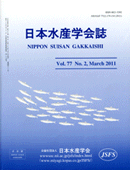Volume 77, Issue 5
Displaying 1-40 of 40 articles from this issue
- |<
- <
- 1
- >
- >|
Technical Achievement Award in Fisheries Science 2010
-
Article type: Technical Achievement Award in Fisheries Science 2010
2011Volume 77Issue 5 Pages 775-778
Published: 2011
Released on J-STAGE: October 11, 2011
Download PDF (708K) -
Article type: Technical Achievement Award in Fisheries Science 2010
2011Volume 77Issue 5 Pages 779-782
Published: 2011
Released on J-STAGE: October 11, 2011
Download PDF (478K) -
Article type: Technical Achievement Award in Fisheries Science 2010
2011Volume 77Issue 5 Pages 783-786
Published: 2011
Released on J-STAGE: October 11, 2011
Download PDF (489K) -
Article type: Technical Achievement Award in Fisheries Science 2010
2011Volume 77Issue 5 Pages 787-790
Published: 2011
Released on J-STAGE: October 11, 2011
Download PDF (283K)
Originals
-
Article type: Originals
2011Volume 77Issue 5 Pages 791-798
Published: 2011
Released on J-STAGE: October 11, 2011
Download PDF (1129K) -
Article type: Originals
2011Volume 77Issue 5 Pages 799-808
Published: 2011
Released on J-STAGE: October 11, 2011
Download PDF (690K) -
Article type: Originals
2011Volume 77Issue 5 Pages 809-821
Published: 2011
Released on J-STAGE: October 11, 2011
Download PDF (1250K) -
Article type: Originals
2011Volume 77Issue 5 Pages 822-833
Published: 2011
Released on J-STAGE: October 11, 2011
Download PDF (1147K) -
Article type: Originals
2011Volume 77Issue 5 Pages 834-844
Published: 2011
Released on J-STAGE: October 11, 2011
Download PDF (1461K) -
Article type: Originals
2011Volume 77Issue 5 Pages 845-852
Published: 2011
Released on J-STAGE: October 11, 2011
Download PDF (1026K) -
Article type: Originals
2011Volume 77Issue 5 Pages 853-861
Published: 2011
Released on J-STAGE: October 11, 2011
Download PDF (792K) -
Article type: Originals
2011Volume 77Issue 5 Pages 862-870
Published: 2011
Released on J-STAGE: October 11, 2011
Download PDF (664K) -
Article type: Originals
2011Volume 77Issue 5 Pages 871-875
Published: 2011
Released on J-STAGE: October 11, 2011
Download PDF (749K) -
Article type: Originals
2011Volume 77Issue 5 Pages 876-880
Published: 2011
Released on J-STAGE: October 11, 2011
Download PDF (689K) -
Article type: Originals
2011Volume 77Issue 5 Pages 881-886
Published: 2011
Released on J-STAGE: October 11, 2011
Download PDF (435K) -
Article type: Originals
2011Volume 77Issue 5 Pages 887-895
Published: 2011
Released on J-STAGE: October 11, 2011
Download PDF (1374K) -
Article type: Originals
2011Volume 77Issue 5 Pages 896-901
Published: 2011
Released on J-STAGE: October 11, 2011
Download PDF (805K)
Short Papers
-
Article type: Short Paper
2011Volume 77Issue 5 Pages 902-904
Published: 2011
Released on J-STAGE: October 11, 2011
Download PDF (306K) -
Article type: Short Paper
2011Volume 77Issue 5 Pages 905-907
Published: 2011
Released on J-STAGE: October 11, 2011
Download PDF (389K)
Featured Articles
Fish resources and fisheries in the Japanese boundary waters Part II
-
Article type: Feature Articles
2011Volume 77Issue 5 Pages 908-914
Published: 2011
Released on J-STAGE: October 11, 2011
Download PDF (370K) -
Article type: Feature Articles
2011Volume 77Issue 5 Pages 915-918
Published: 2011
Released on J-STAGE: October 11, 2011
Download PDF (466K) -
Article type: Feature Articles
2011Volume 77Issue 5 Pages 919-923
Published: 2011
Released on J-STAGE: October 11, 2011
Download PDF (612K) -
Article type: Feature Articles
2011Volume 77Issue 5 Pages 924-927
Published: 2011
Released on J-STAGE: October 11, 2011
Download PDF (451K)
Damages to fisheries by the Great East Japan Earthquake and tsunami disasters
-
Article type: Damages to fisheries by the Great East Japan Earthquake and tsunami disasters
2011Volume 77Issue 5 Pages 929-930
Published: 2011
Released on J-STAGE: October 11, 2011
Download PDF (210K) -
Article type: Damages to fisheries by the Great East Japan Earthquake and tsunami disasters
2011Volume 77Issue 5 Pages 931-933
Published: 2011
Released on J-STAGE: October 11, 2011
Download PDF (567K)
News
-
Article type: News
2011Volume 77Issue 5 Pages 934-937
Published: 2011
Released on J-STAGE: October 11, 2011
Download PDF (535K)
Highlights in Fisheries Science Research
-
Article type: Highlights in Fisheries Science Research
2011Volume 77Issue 5 Pages 938
Published: 2011
Released on J-STAGE: October 11, 2011
Download PDF (243K) -
Article type: Highlights in Fisheries Science Research
2011Volume 77Issue 5 Pages 939
Published: 2011
Released on J-STAGE: October 11, 2011
Download PDF (260K) -
Article type: Highlights in Fisheries Science Research
2011Volume 77Issue 5 Pages 940
Published: 2011
Released on J-STAGE: October 11, 2011
Download PDF (247K) -
Article type: Highlights in Fisheries Science Research
2011Volume 77Issue 5 Pages 941
Published: 2011
Released on J-STAGE: October 11, 2011
Download PDF (222K) -
Article type: Highlights in Fisheries Science Research
2011Volume 77Issue 5 Pages 942
Published: 2011
Released on J-STAGE: October 11, 2011
Download PDF (229K) -
Article type: Highlights in Fisheries Science Research
2011Volume 77Issue 5 Pages 943
Published: 2011
Released on J-STAGE: October 11, 2011
Download PDF (263K) -
Article type: Highlights in Fisheries Science Research
2011Volume 77Issue 5 Pages 944
Published: 2011
Released on J-STAGE: October 11, 2011
Download PDF (201K) -
Article type: Highlights in Fisheries Science Research
2011Volume 77Issue 5 Pages 945
Published: 2011
Released on J-STAGE: October 11, 2011
Download PDF (248K)
-
Article type: New Books
2011Volume 77Issue 5 Pages 946-947
Published: 2011
Released on J-STAGE: October 11, 2011
Download PDF (234K)
Topics
-
Article type: Topics
2011Volume 77Issue 5 Pages 948-949
Published: 2011
Released on J-STAGE: October 11, 2011
Download PDF (480K) -
Article type: Topics
2011Volume 77Issue 5 Pages 950
Published: 2011
Released on J-STAGE: October 11, 2011
Download PDF (206K)
-
Article type: Topics
2011Volume 77Issue 5 Pages 951-952
Published: 2011
Released on J-STAGE: October 11, 2011
Download PDF (549K)
Abstracts of Original Papers
-
2011Volume 77Issue 5 Pages 953-955
Published: 2011
Released on J-STAGE: October 11, 2011
Download PDF (311K) -
2011Volume 77Issue 5 Pages 956-960
Published: 2011
Released on J-STAGE: October 11, 2011
Download PDF (391K)
- |<
- <
- 1
- >
- >|
